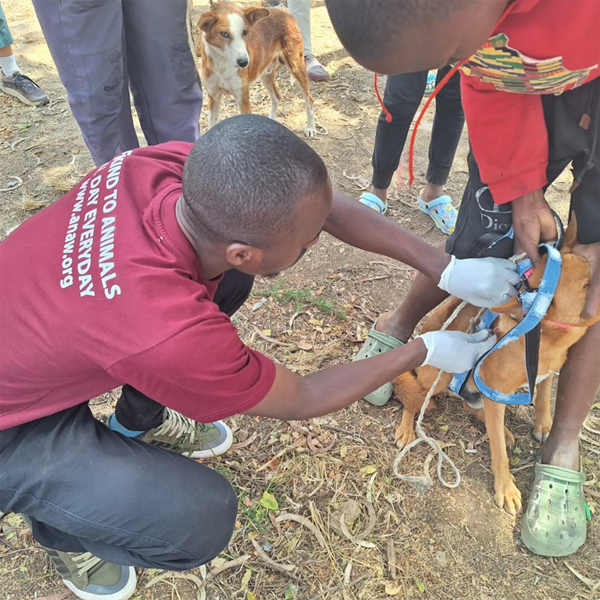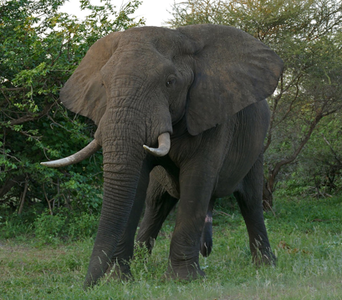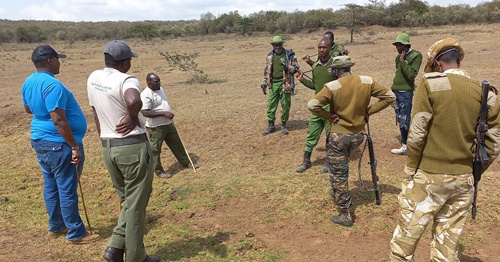World Animal Day 2023
Great or small, Love them all.
 We are pleased to join the world in celebrating World Animal Day under the theme ‘Great or small love them all’. This year’s theme resonates well with what we do at Africa Network for Animal Welfare (ANAW) where animals are at the center of our focus. We believe that animal are sentient beings and they should not suffer. Many animals, just as humans have a conscience and are able to feel emotions such as love, happiness and pain. An animal’s cry expresses pain and not just mere noise. Whether they are small or big, there might be a reason for that cry. With a little love and care that may change.
We are pleased to join the world in celebrating World Animal Day under the theme ‘Great or small love them all’. This year’s theme resonates well with what we do at Africa Network for Animal Welfare (ANAW) where animals are at the center of our focus. We believe that animal are sentient beings and they should not suffer. Many animals, just as humans have a conscience and are able to feel emotions such as love, happiness and pain. An animal’s cry expresses pain and not just mere noise. Whether they are small or big, there might be a reason for that cry. With a little love and care that may change.
There are several changes that are happening affecting animals. For instance, the effects of climate change have not spared the animals. It has brought about the changing ecosystems, shrinking habitats, animal migratory shifts that are caused by shifts in temperatures, increased rates of diseases as well as imbalance in incubation periods. Human needs such as infrastructural development and mining have not spared the animals. The changes cause situations where animals are unable to cope naturally causing pain, discomfort and distress.
As humans, we have an obligation to love and protect all the animals. We appreciate and support what the Kenya government and other nations are doing to curb the effects of climate change. Simple actions such as planting of trees to protect their habitats can make a positive difference.
There are many ways we can help animals feel loved and cared. At ANAW, we have various activities that are geared towards promoting love, care and kindness to animals. Our staff and volunteers participate in routine ecological monitoring where we monitor wildlife movements and assisting in prevention of conflicts even before they happen through desnaring and animal rescues with our partner Kenya Wildlife Service. In addition, we work in collaboration with groups of people affiliated by geographic proximity, education, special interests or are similarly working to address issues affecting the wellbeing of animals and the people.
The young generation is not left behind. ANAW Promotes animal welfare in school empowering the next generation with animal welfare knowledge through the animal welfare clubs. We educate children to be front-runners in loving and caring for the animals.
Our work is not only on wildlife but also domestic and working animals where we provide regular free vaccinations to pets as well as pet owners’ education contributing both to the animals’ health and the health of the people around them.
We work with governments and like-minded stakeholders to carry out interventions that contribute towards maintaining a balance between various human practice and animal survival.
On the continental front, we host the Africa Animal Welfare Conferences where we partner with United Nation Environmental Program UNEP, African Union InterAfrican Bureau for Animal Resources (AUIBAR) and the government of the country in which the conference is held to cohost Africa Animal Welfare Conference annually. The Conference is a platform for animal welfare stakeholders in Africa to engage in dialogue, learning and strategy development to address circumstances and developments in animal welfare. It highlights a broad number of issues regarding animal welfare, environment and sustainable development in Africa.
It is indeed a duty of all of us to protect and love all the animals great or small.
Josphat Ngonyo
Executive Director - ANAW.

 Hearing about the Watha and their history, left me feeling rather lost in time as I wondered where we or they have been. It appears that we left them behind going on with life in the city oblivious of the plight of a people who have always been part of Kenya. Historically, these are a community of hunters and gatherers that lived off bush meat and traded in wildlife items such as rhino horns and elephant tusks. Their knowledge of the bush and game hunting which was once profitable, in the days of hunting safaris, now leads to their arrest and imprisonment. Their former lifestyle is no longer sustainable in the modern context and the area they once lived in and lived off was taken from them to create the current Tsavo East National Park.
Hearing about the Watha and their history, left me feeling rather lost in time as I wondered where we or they have been. It appears that we left them behind going on with life in the city oblivious of the plight of a people who have always been part of Kenya. Historically, these are a community of hunters and gatherers that lived off bush meat and traded in wildlife items such as rhino horns and elephant tusks. Their knowledge of the bush and game hunting which was once profitable, in the days of hunting safaris, now leads to their arrest and imprisonment. Their former lifestyle is no longer sustainable in the modern context and the area they once lived in and lived off was taken from them to create the current Tsavo East National Park. An exhausted hardworking team felt the draft of the city life in the rescue vehicle the minute they hit Mlolongo along Mombasa Road. It was a composite din of matatus honking in traffic, the vendors shouting out affordable prices and clustered hordes of people crossing under various flyovers on the highway in the urban concrete jungle. The fatigue and sudden noise that marked the hustle and bustle of city life did not wan their spirits.
An exhausted hardworking team felt the draft of the city life in the rescue vehicle the minute they hit Mlolongo along Mombasa Road. It was a composite din of matatus honking in traffic, the vendors shouting out affordable prices and clustered hordes of people crossing under various flyovers on the highway in the urban concrete jungle. The fatigue and sudden noise that marked the hustle and bustle of city life did not wan their spirits.